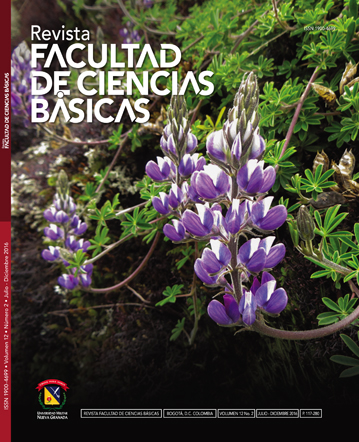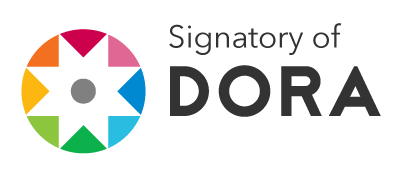Diversidad de los compuestos orgánicos bioactivos de origen natural: una singularidad manifestada por la plasticidad en el metabolismo secundario
Resumen
El uso de compuestos orgánicos de origen natural (i.e., metabolitos secundarios) es una de las formas de aprovechamiento de los organismos más comunes e importantes, entre los que se destacan plantas y microorganismos. La utilidad de estos compuestos se enfoca a diversos escenarios, en el que se resaltan los productos bioactivos, los cuales marcan una fuerte presencia en el control de enfermedades y dolencias. Aunque ya se cuenta con información substancial y significativa relativa a la función que cumplen tales metabolitos secundarios en los organismos que los producen, todavía se desconoce mucho al respecto, sobretodo en el caso de las plantas. Esto se debe quizá a que, en cierta medida, el metabolismo secundario se suele a menudo considerar aparte de las funciones esenciales de la célula. No obstante, existe evidencia de la clara y estrecha relación que se presenta entre metabolismo celular fundamental y las vías bioquímicas que conducen a la síntesis de metabolitos secundarios. Lo anterior permite que el metabolismo secundario se regule por una sofisticada red de comunicación y señalización a escala celular y tisular, lo que le permite manifestarse con el nivel de plasticidad requerido para adaptarse e interactuar con su entorno. Por tanto, debido al hecho que el metabolismo secundario sea tan versátil, permite la biosíntesis de diversos grupos de estructuras biológicamente activas que, por consiguiente, trasciende en la acción y roles de tales productos secundarios, como es el caso de los compuestos fenólicos y las sesquiterpenlactonas.
Descargas
Referencias bibliográficas
• Aguilar-Støen, M., Moe, S.R. 2007. Medicinal plant conservation and management: distribution of wild and cultivated species in eight countries. Biodiversity and Conservation 16: 1973–1981.
• Ahmed, S., Abdelgaleil, S. 2005. Antifungal activity of extracts and sesquiterpenes from Magnolia grandiflora L. (Magnoliaceae). International Journal of Agriculture and Biology 7: 638–642.
• Anderson, J.T. 2016. Plant fitness in a rapidly changing world. New Phytologyst 210(1): 81-7.
• Ashihara, H., Sano, H., Crozier, A. 2008. Caffeine and related purine alkaloids: biosynthesis, catabolism, function and genetic engineering. Phytochemistry 841–856.
• Avanci, N.C., Luche, D.D., Goldman, G.H., Goldman, M.H. 2010. Jasmonates are phytohormones with multiple functions, including plant defense and reproduction. Genetics and Molecular Research: 484–505.
• Azzedine, F., Gherroucha, H., Baka, M. 2011. Improvement of salt tolerance in Durum wheat by ascorbic acid application. Physiology and Biochemestry 7: 27–37.
• Bais, H.P., Vepachedu, R., Gilroy, S., Callaway, R.M., Vivanco, J.M. 2003. Allelopathy and exotic plant invasion: from molecules and genes to species interactions. Science 301: 1377–1380.
• Baker, E.A. 1982. Chemistry and morphology of plant epicuticular waxes. In: Cutler D.J., Alvin K.L., Price C.E (eds). The Plant Cuticle. Londres, Academic Press, 139-165pp.
• Baya, M., Soulounganga, P., Gelhaye, E., Gerardin, P. 2001. Fungicidal activity of b-thujaplicin analogues. Pest Manage Science 57: 833– 838.
• Bohlmann, J., Stauber, E.J., Krock, B., Oldham, N.J., Gershenzon, J., Baldwin, I.T. 2002. Gene expression of 5-epi-aristolochene synthase and formation of capsidiol in roots of Nicotiana attenuata and N. sylvestris. Phytochemistry 60: 109–116.
• Bourgaud, F., Gravoy, A., Milesi, S., Gontier, E. 2001. Production of plant secondary metabolites: a historical perspective. Plant Science 161: 839 – 851.
• Briskin, D.P. 2000. Medicinal plants and phytomedicines. Linking plant biochemistry and physiology to human health. Plant Physiology 124:507–514.
• Chaturvedi, D. 2011. Sesquiterpene lactones: structural diversity and their biological activities, In: Opportunity, Challenge and Scope of Natural Products in Medicinal Chemistry, Research Signpost, Kerala, India, Cap 10, 313-334pp.
• Chen, H.C., Chou, C.K., Lee, S.D., Wang, J.C., Yeh, S.F. 1995. Active compounds from Saussurea lappa Clarks that suppress hepatitis B virus surface antigen gene expression in human hepatoma cells. Antiviral Research 27: 99-109.
• Chen, Z., Gallie, D.R., 2008. Dehydroascorbate reductase affects non-photochemical quenching and photosynthetic performance. Journal of Biological Chemistry 283: 21347– 21367.
• Conforti F., Menichini F., Formisano C., Rigano D., Senatore F., Arnold N.A., Piozzi F. 2009. Comparative chemical composition, free radical-scavenging and cytotoxic properties of essential oils of six Stachys species from different regions of the Mediterranean Area. Food Chemistry 116: 898–905.
• Demidchik V. 2015. Mechanisms of oxidative stress in plants: From classical chemistry to cell biology. Environmental and Experimental Botany 109:212-228.
• Dewick, P. M. 2002. Medicinal natural products. A biosynthetic approach. New York, Wiley 507pp.
• Foyer, C.H., Shigeoka, S. 2011. Understanding Oxidative Stress and Antioxidant Functions to Enhance Photosynthesis. Plant Physiology 155:93-100.
• Galeotti, F., Barile, E., Curir, P., Dolci. M., Lanzotti, V. 2008. Flavonoids from carnation (Dianthus caryophyllus) and their antifungal activity. Phytochemistry Letters 1: 44 – 48.
• Gechev, T.S., Van Breusegem, F., Stone, J.M., Denev, I., Laloi, C. 2006. Reactive oxygen species as signals that modulate plant stress responses and programmed cell death. Bioessays 28: 1091–1101.
• Hadacek, F. 2002. Secondary metabolites as plant traits: current assessment and future perspectives. Critical Reviews in Plant Sciences 21: 273-322.
• Hansson, D., Menkis, A., Himmelstrand, K., Thelander, M., Olson, A et al., 2012. Sesquiterpenes from conifer root rot pathogen Heterobasidion occidentale. Phytochemistry 82: 158–165.
• Harbone, J.B. 1999a. Classes and functions of secondary products, in: N.J. Walton, D.E. Brown (Eds), Chemicals from Plants: Perspectives on Plant Secondary Products. Londres, Imperial College Press, Cap 1, 1-26.
• Harborne, J.B, Baxter, H., Moss, G.P. 1999b. Phytochemical dictionary: handbook of bioactive compounds from plants. Segunda edición, Londres: Taylor & Francis.
• Harborne, J. B. 2009. Introduction to ecological biochemistry, 4th edition. Londres, Academic Press 380pp.
• Hooper L., Cassidy, A. 2006. A review of the health care potential of bioactive compounds. Journal of the Science of Food and Agriculture. 86:1805–1813.
• Inderjit, A., Weiner, J. 2001. Plant allelochemical interference or soil chemical ecology?. Perspective in Plant Ecology Evolution and Systematics 4: 4–12.
• Jilani, G., Mahmood, S., Chaudhry, A.N., Hassan, I., Akram, M. 2008. Allelochemicals: sources, toxicity and microbial transformation in soil – a review. Annals of Microbiology 58: 351–357.
• Jiménez J.P., Serrano, J., Tabernero, M., Arranz, S., Díaz, M.E., García, Goñi I., Saura-Calixto F. 2008. Effects of grape antioxidant dietary fiber in cardiovascular disease risk factors. Nutrition 24: 646–53.
• Kaur, H., Kaur, R., Kaur, S., Baldwin, I.T., Inderjit. 2009. Taking ecological function seriously: soil microbial communities can obviate allelopathic effects of released metabolites. Plos One Journal 4: e4700.
• Kerchev, P.I., Pellny, T.K., Vivancos, P.D., Kiddle, G., Hedden, P., Driscoll, S., Vanacker, H., Verrier, P., Hancock, R.D., Foyer, C.H. 2011. The transcription factor ABI4 is required for the ascorbic acid-dependent regulation of growth and regulation of jasmonate-dependent defense signaling pathways in Arabidopsis. Plant Cell 23: 3319–3334.
• Kessler, A., Halischke, R., Baldwin, I. T. 2004. Silencing the jasmonate cascade: Induced plant defences and insect populations. Science 305: 665–668.
• Kircher, H.W., Lieberman, F.V. 1967. Toxicity of tobacco smoke to the spotted alfalfa aphid Therioaphis maculata (Buckton). Nature 215: 97–98.
• Kistler, H.C., Broz, K. 2015. Cellular compartmentalization of secondary metabolism. Frontiers in Microbiology 6:68.
• Kossel, A. 1891. Über die Chemische Zusammensetzung der Zelle. Archiv für Physiologie 4:181 – 186.
• Kris-Etherton, P.M., Hecker, K. D., Bonanome, A., Coval, S.M., Binkoski, A.E., Hilpert, K.F, et al. 2002. Bioactive compounds in foods: their role in the prevention of cardiovascular disease and cancer. American Journal of Medicine 113: 71-88.
• Li, J., Ou-Lee, T. M., Raba, R., Amundson R. G., Last. R. L. 1993. Last Arabidopsis mutants are hypersensitive to UV-B radiation. The Plant Cell 5: 171–179.
• Li, J.H., Liu, Y.O., Lü, P., Lin, H.F., Bai, Y., Wang, X.C., Chen, Y.L. 2009. A signaling pathway linking nitric oxide production to heterotrimeric G protein and hydrogen peroxide regulates extracellular calmodulin induction of stomatal closure in Arabidopsis. Plant Physiology 150: 114–124.
• Maldonado-Bonilla, L.D., Betancourt-Jiménez, M., Lozoya-Gloria, G. E. 2008. Local and systemic gene expression of sesquiterpene phytoalexin biosynthetic enzymes in plant leaves. European Journal of Plant Pathology 121: 439–449.
• Martins, S. Mussatto, S. I., Martins, G., Saenz, J. M., Aguilar, C. N., Teixeira, J. A. 2011. Bioactive phenolic compounds: production and extraction by solid state fermentation. Biotechnology Advances 29: 365 – 373.
• Meng, J.C., Hu, Y.F., Chen, J.H., Tan, R.X. 2001. Antifungal sesquiterpenes and other constituents from Ajania fruticulosa. Phytochemistry 58: 1141–1145.
• Minto, R.E., Blacklock, B.J. 2008. Biosynthesis and function of polyacetylenes and allied natural products. Progress in Lipid Research 47: 233–306.
• Modzelewska, A., Sur, S., Kumar, S.K., Khan, S.R. 2005. Sesquiterpenes: natural products that decrease cancer growth. Current Medicinal Chemistry Anticancer Agents 5:477-499.
• Niño GEA, Torrenegra RD. 2011. Extracción, Separación e Identificación de la Sustancia Activa Producida por Espeletia killipii como Defensa Ante el Ataque de Larvas de Lepidóptero. Revista Facultad de Ciencias Básicas, 7:126 – 133.
• Nigam PS, Gupta N, Anthwal A. Pre-treatment of agro-industrial residues. 2009. In: Nigam PS, Pandey A, editors. Biotechnology for agro-industrial residues utilization. First ed. Netherlands: Springer, 13–33p.
• Ogita, S., Uefuji, H., Yamaguchi, Y., Koizumi, N., Sano, H. 2003. RNA interference: Producing decaffeinated coffee plants. Nature 423: 823.
• Pandey K. B., Rizvi S. I. 2009. Plant polyphenols as dietary antioxidants in human health and disease. Oxidative Medicine Cellular Longevity 2: 270–278.
• Pandey D.K. 2009. Allelochemicals in Parthenium in response to biological activity and the environment. Indian Journal of Weed Science 41: 111-123.
• Perry, L.G., Thelen, G.C., Ridenour, W.M., Callaway, R.M., Paschke, M.W., Vivanco, J.M. 2007. Concentrations of the allelochemical (±)-catechin in Centaurea maculosa soils. Journal of Chemical Ecology 33: 2337–2344.
• Phung, T., Jung, H., Park, J.H., Kim, J.G., Back, K., Jung, S. 2011. Porphyrin biosynthesis control under water stress: sustained porphyrin status correlates with drought tolerance in transgenic rice. Plant Physiology 157:1746-1764.
• Picman, A. 1983. Antifungal Activity of helenin and isohelenin. Biochemical Systematics and Ecology 11: 183–186.
• Picman, A. 1986. Biological activities of sesquiterpene lactones. Biochemical Systematics and Ecology 14: 255-281.
• Ralston, L., Tae kwon, S., Schoenbeck, M., Ralston, J., et al., 2001. Cloning, heterologous expression, and functional characterization of 5-epi-Aristolochene-1,3-Dihydroxylase from Tobacco (Nicotiana tabacum). Archives of Biochemistry and Biophysics 393: 222- 235.
• Rosenthal, G. A., Berenbaum, M. R. 1992. Herbivores: their interactions with secondary plant metabolites. San Diego, Academic Press 452pp.
• Roze L.V., Chanda, A., Linz J.E. 2011. Compartmentalization and molecular traffic in secondary metabolism: a new understanding of established cellular processes. Fungal Genetics and Biology 48: 35-48.
• Saad, M.M.G., Abdelgaleil, S.A.M., Suganuma, T. 2012. Herbicidal potencial of sesquiterpenes on wild oat, Avena fatia L. Biochemical Systematics and Ecology 44: 33 -337.
• Seigler, D. S. 2003. Plant secondary metabolism. Boston, Dordrecht, London: Kluwer Academic Publishers 759pp.
• Shoji, T., Yamada, Y., Hashimoto, T. 2000. Jasmonate induction of putrescine N-methyltransferase genes in the root of Nicotiana sylvestris. Plant Cell Physiology 41: 831–839.
• Stark, S., Kytöviita, M.M., Neumann, A.B. 2007. The phenolic compounds in Cladonia lichens are not antimicrobial in soils. Oecologia 152, 299–306.
• Skaltsa H., Lazari D., Panagouleas C., Georgiadou E., Garcia B., Sokovic M. 2000. Sesquiterpene lactones from Centaurea thessala and Centaurea attica. Antifungal activity. Phytochemistry 55: 903-908.
• Swain, T. 1977. Secondary compounds as protective agents. Annual Review of Plant Physiology 28:479–501.
• van Breusegem, F., Dat, J.F. 2006. Reactive oxygen species in plant cell death. Plant Physiology 141: 384–390.
• van Wyk, B. E., Wink, M. 2004. Medicinal plants of the world. Portland, USA, Timber Press Inc., 480pp.
• Vialart, G., Hehn, A., Olry, A., Ito, K., Krieger, C., Larbat, R., Paris, C., Shimizu, B.-I., Sugimoto, Y., Mizutani, M., Bourgaud, F. 2012. A 2-oxoglutarate-dependent dioxygenase from Ruta graveolens L. exhibits p-coumaroyl CoA 2-hydroxylase activity (C2 H): a missing step in the synthesis of umbelliferone in plants. The Plant Journal 70:460–470.
• Voukeng I.K, Kuete V., Dzoyem J.P., Fankam A.G., Noumedem J.A.K., Kuiate J.R., Pages J.M. 2012. Antibacterial and antibiotic-potentiation activities of the methanol extract of some cameroonian spices against Gram-negative multi-drug resistant phenotypes. BMC Research Notes 5:299.
• Wang, L. Y., Wei, K., Jiang, Y. W., Cheng, H., Zhou, J., He, W., Zhang C. C. 2011. Seasonal climate effects on flavanols and purine alkaloids of tea (Camellia sinensis L.). European Food Research and Technology 233: 1049–1055.
• Wink, M. 2003. Evolution of secondary metabolites from an ecological and molecular phylogenetic perspective. Phytochemistry 64: 3–19.
• Wink, M. 2006. Importance of plant secondary metabolites for protection against insects and microbial infections, Chapter 11. In: Rai, M., Carpinella, M.C. (Eds), Advances in Phytomedicine, Ed. Elsevier, 3:251-268.
• Nuñez Y.O., Salabarria I.S., Collado I.G., Hernández-Galán R. 2007. Sesquiterpenes from the wood of Juniperus lucayana. Phytochemistry 68: 2409 – 2414.
• Yazaki, K. 2004. Natural Products and Metabolites. In: Klee, H. and Christou, P., (Eds.) Handbook of Plant Biotechnology. John Wiley & Sons Ltd. 811–857 pp.
• Yen T.B., Chang H.T., Hsieh C.C., Chang S.T. 2008. Antifungal properties of ethanolic extracts and its active compounds from Calocedrus macrolepis var. formosana (Florin) wood. Bioresource Technology 99: 4871–4877.












